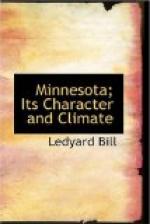The Falls of Minneopa are near here and are worth a visit from the tourist. Some esteem them as excelling in attractiveness any and all others in the State.
The prairies beyond Mankato, along the St. Paul and Sioux City Railway, afford the best “chicken” shooting that we know of, and much of the hunting for this game is done along the line of this road.
The southeastern section of the State, in which are situated Rochester, Owatonna, and Austin, and other budding cities, is, at present, with the valley of the Minnesota, the great wheat-growing region. But it is not alone in the cultivation of serials that the farmers may become “fore-handed.” The climate is favorable to nearly all of the products of the middle and northern portions of the Union, with some kinds of fruit excepted. Indeed, we found growing in the garden of Horace Thompson, in St. Paul, the southern cotton-plant, which (while the seed had not been planted by ten days as early as it might have been in the spring) was in bloom in August, and by September it had begun to boll, and another fortnight would have easily matured portions of the same. This illustrates in a general way the length and power of the growing season in this State. The climate, so far as crops are concerned, is perhaps a counterpart of New England.
Here, in this southeast section, are the handsome homes and well-filled barns of an industrious and thrifty people. The traveller through this beautiful portion of the State can scarce keep from breaking one of the ten commandments as he witnesses a people so well to do and so happy in the possession of their productive acres.
Here, all immigrants may, by following out to the terminus of the penetrating railways, find cheap and good lands awaiting them, and where just as beautiful homes may be made as in that portion nearer the river—now teeming with life and industries—but which, a few brief years since, was as desolate and untenanted as are the unbroken prairies to the westward. The prices vary, according to location and character, from five to fifteen dollars per acre, though a majority of the wild lands can be had at from six to eight dollars. The “St. Paul and Sioux City Road” have thousands of acres along their line which they are ready and anxious to dispose of to settlers. The value of these lands is usually doubled the moment they are broken and occupied even with but inferior buildings—only so that shelter is obtained. For “new comers,” wishing new lands, this road and that of the “St. Paul and Pacific Main Line Railway,” at Wilmar, and on to the fertile valley of the Red River, afford, in our judgment, the best lands. This latter road, now that it is under the control of the Northern Pacific Railway Company, is destined to play an important part in the settlement and development of that vast region—so rich in agricultural wealth—lying along the Red, Saskatchawan, and Assiniboine Rivers. It must indeed prove the link which some day, in the near future, will bind the new province of Manitoba and the adjacent country to the northwest of it.




